In January 2023, Medellín increased fares for the metro system in the city. So, we provide an up-to-date Medellín Metro guide with the new fares along with tips for using the metro system in Medellín.
Medellín has the only rail-based metro system in Colombia. But this mass transportation system is much more than a rail-based system.
Medellín’s metro system is a comprehensive transportation system that integrates two rail lines, a Tranvía tramcar line, six Metrocable cable-car lines, two Metroplús elongated bus line an electric bus line and even hundreds of small feeder metro buses.
The comprehensive system in Medellín consists of:
- Two rail lines – Line A (north to south) with 21 stations and Line B (center to west) with six stations.
- Seven Metrocable cable car lines – Line H with two stations, Line J with three stations, Line K with three stations, Line M with three stations and Line L with two stations and the newest line P with three stations.
- One Tranvía tramcar line – Line T-A with nine stations.
- Two Metroplús elongated bus lines – Line 1 with 20 stations and Line 2 with eight stations.
- Line O – an electric bus line with 80 buses going from the Caribe metro station to the La Palma Metroplús station with 14 stops.
- Over 200 metro feeder buses that connect to/from the metro stations with routes to and from many neighborhoods in the Medellín metropolitan area, also known as the Aburrá Valley.
EDITORS NOTE: Starting on April 7, 2020, due to the coronavirus pandemic, it became required to wear face masks on the Medellín Metro system and also on all buses in Medellín. See the following El Colombiano article in Spanish. If you don’t have a face mask, you won’t be permitted on the metro system or buses in Medellín. This requirement is still being enforced in 2021. However, after the end of the pandemic was declared, in 2023 the use of face masks is no longer mandatory
Note the above photo is of Line A in El Centro in Medellín with Hotel Nutibara in the background.

Medellín Metro train arriving at a station
New 2023 Medellín Metro System Fares
The 2023 standard Medellín Metro fare with a personalized Civica card is 2,880 pesos ($0.73 USD), which is up from 2,580 pesos in 2020 and up from 2,355 pesos in 2019. And a personalized Civica card is free.
In addition, the fare with a personalized Civica card can go as high as 4,650pesos. For example, if you use a Metrocable with train plus two feeder buses
The standard fare in 2023 if you don’t have a personalized Civica card is 3,280 pesos ($0.81 USD), which is up from 2,750 pesos in 2020. The standard fare is the fare with the eventual Civica cards that are sold at fare booths at metro stations. It now costs 10,000 pesos to get an eventual Civica card at a fare booth that is rechargeable.
So, you save 320 pesos (11.6 percent) per standard trip with a personalized Civica card. As a result of using a personalized Civica card I estimate I save over $60 USD per year with lower fares.
The Metrocable line to Parque Arvi (Line L) has a separate fare of 12,500 pesos unless you are part of Sisbén, which will result in a lower fare.
The following is a table of 2023 fares. Most notably, the first Frequente fare is for people with a personalized Civica card:
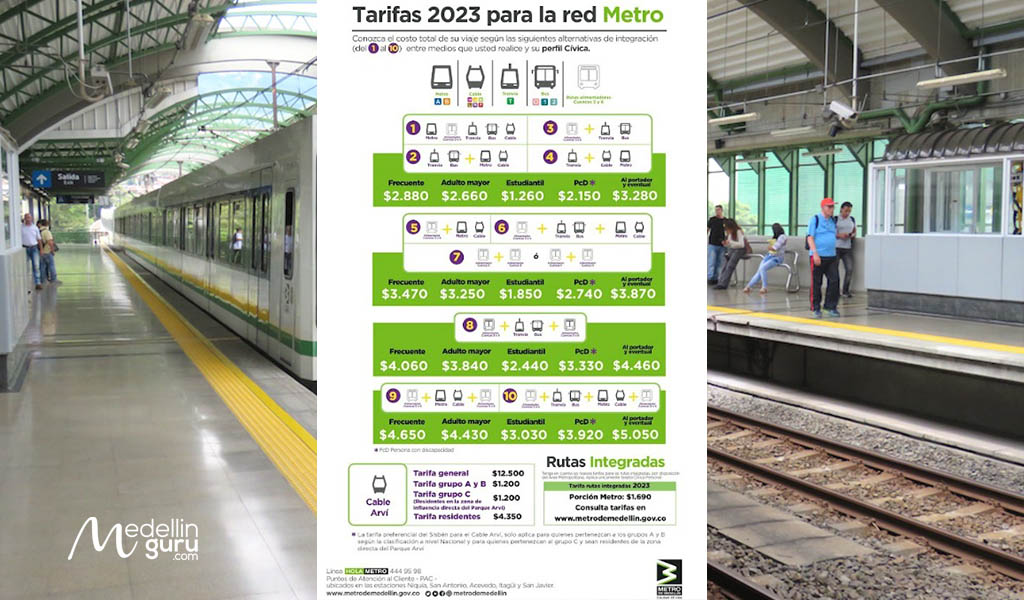
2023 Medellín metro fares, courtesy of Metro de Medellín
Furthermore, discounted fares are available as shown in the table for those over 60 years old (Adulto Mayor), students (Estudiantial), people with reduced mobility (PcD) and package carriers (Al Portador). When you sign up for a Civica card you can establish the discounted fares for your Civica card if you are eligible.
However, if you receive a discount you can’t use your Civica card for other passengers. For example if you sign up for a discount for being over 60 years old, the card only works once and won’t work again for the same entrance for about 30 minutes. This is to prevent people with discounts from providing discounted fares to others who aren’t eligible.
Integrated Metro Fares for 2023
The integrated fares for integrated buses and the metro have also changed and range from 1,700 to 5,140 pesos.
The integrated buses now have Civica readers. You will need a Civica card to get the integrated fare. And if you pay the integrated bus driver with cash you can’t get the lower integrated fare.

Cable cars on Metrocable Line K
History of the Medellín Metro System
The history of the Medellín Metro system traces back to 1980, when the project was presented to the Colombian National Government by the city of Medellín. The project was approved in 1982 by the National Council of Economic and Social Policies.
The Medellín Metro was conceived as a major urban transportation system for the worker classes in Medellín. In addition, it was envisioned to help develop marginalized portions of the city with limited transportation options, which are also some of the poorest neighborhoods in the city.
The massive construction project was contracted to German and Spanish firms in 1984. And the first journey on the Line A rail line was on November 30, 1995 between the Niquia and Poblado stations.
The system has continued to expand since the first rail line was installed. The Line B rail line was added in February 1996. And Line A was expanded south in 2012 to add the Sabaneta and La Estrella stations.
In July 2004, the first Metrocable Line K was added. And in March 2008, the second Metrocable Line J was added. In September 2010, Line L to Parque Arvi was added. And in December 2016, the fourth Metrocable Line H was added.
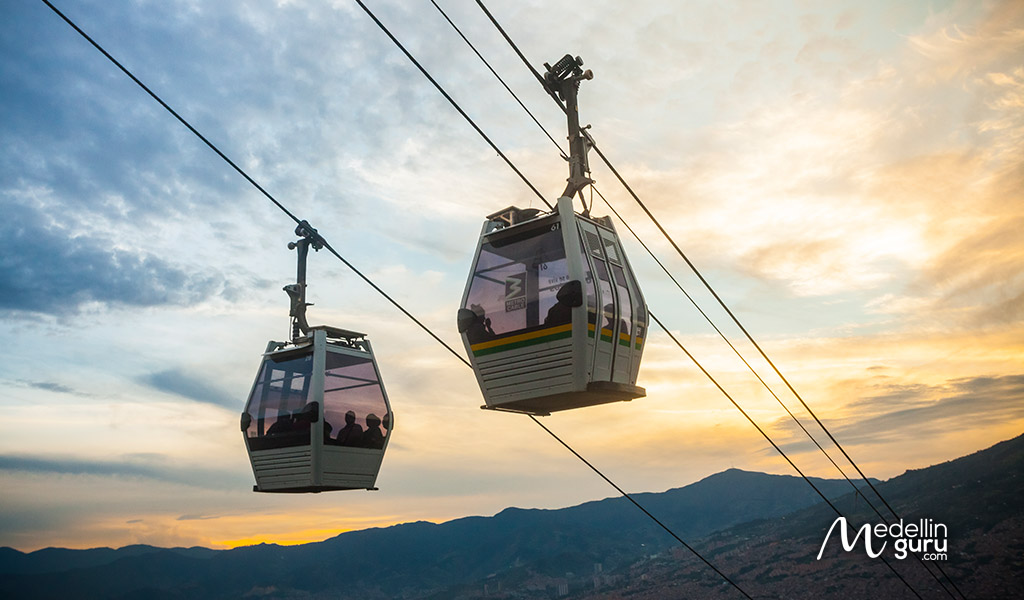
Metrocable Line M completed construction in January 2019 and opened on February 13, 2019
The latest addition is the fifth Metrocable Line M that completed construction in January 2019 and is was tested before becoming operational on February 13, 2019. Line M has three stations and 49 cable cars and connects to the Tranvía tramcar Line T-A at Miraflores station.
In 2023, the possibility of building another line for the San Antonio de Prado Metrocable is being evaluated, to continue connecting all the towns of the city.
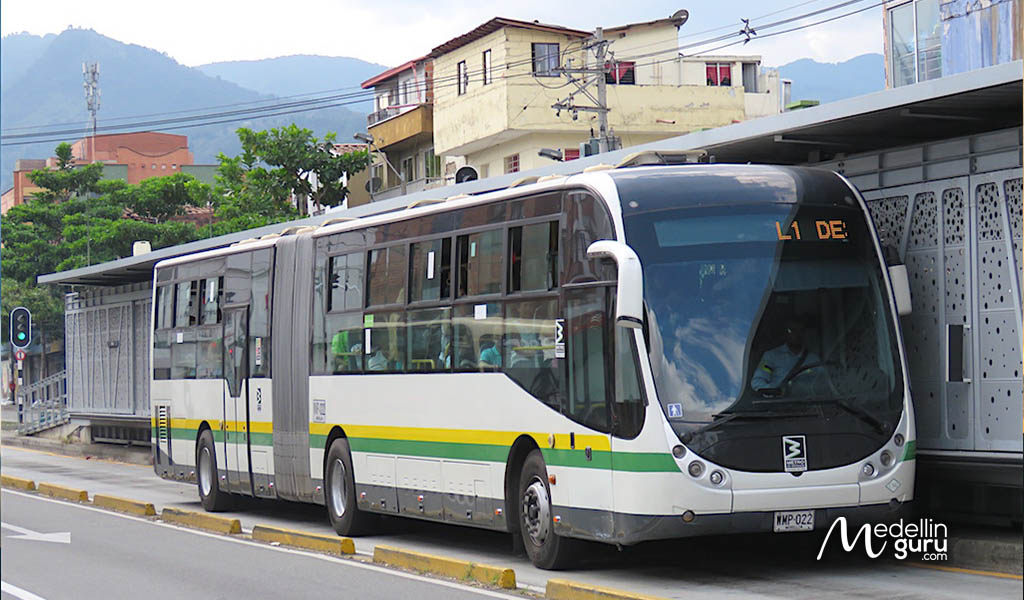
Metroplús bus line 1
The first Metroplús bus elongated bus line, Line 1, was added in December 2011 and Line 2 was added in April 2013.
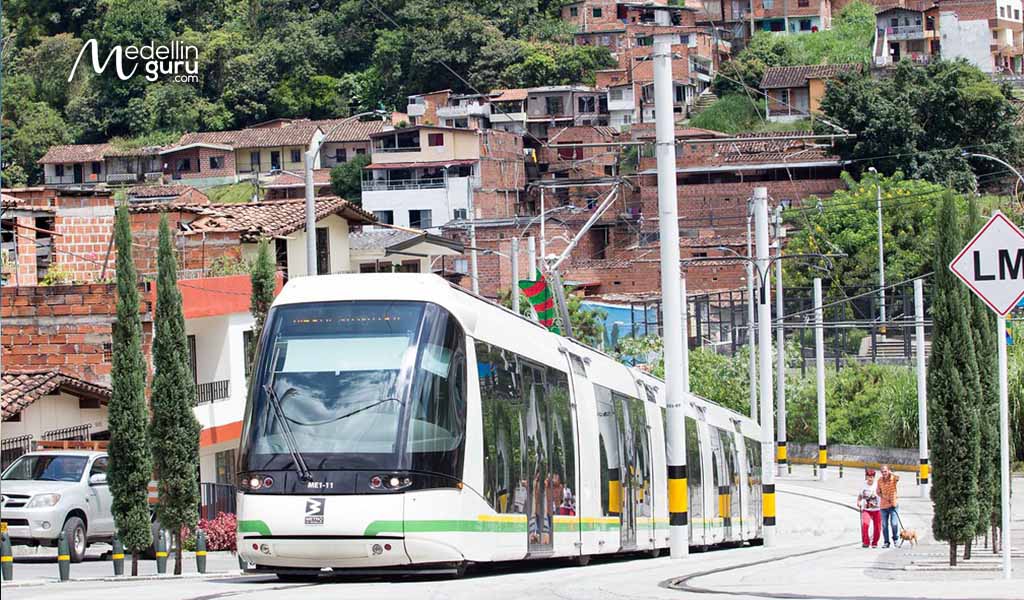
Tranvía tram at the San Jose station
In addition, the Tranvía tramcar Line T-A officially started service in March 2016 but it opened earlier for trial runs.
Also, in 2018 the system added monitors at many of the stations that show a color-coded status of the metro line and how much time until the next trains arrive.
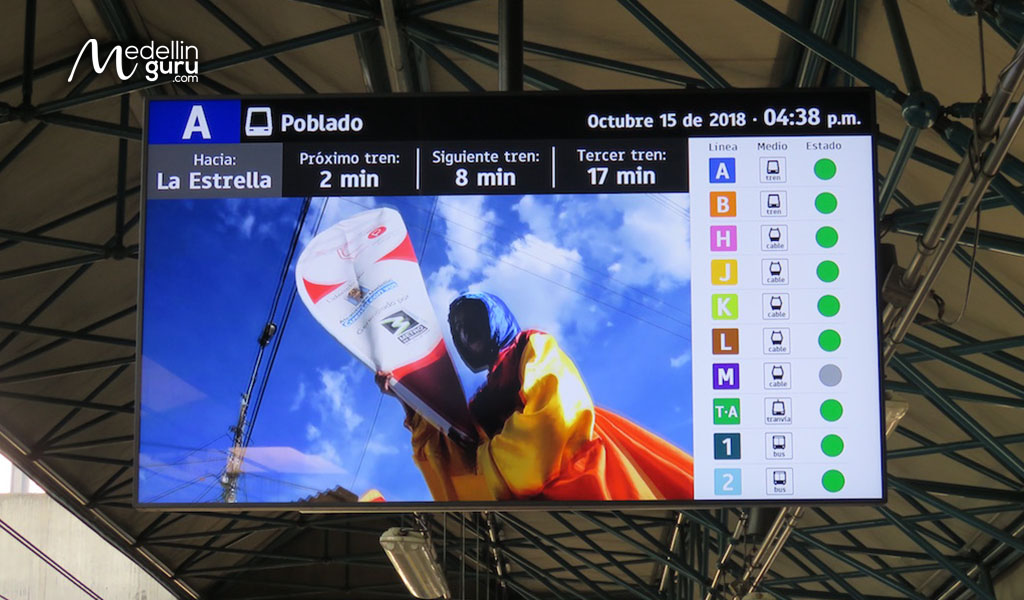
Monitors added in 2018 in metro stations showing the status of the metro system
The Medellín Metro system was named one of the top transport systems in the world by the Institute for Transportation and Development Policy (ITDP) in 2012. ITDP is global consortium of organizations founded to promote sustainable transportation systems worldwide.
It is estimated that the Medellín Metro transports around 800,000 people daily. In addition, the metro reportedly saves over 200,000 tons of CO2 emissions each year. In addition, it greatly reduces the amount of traffic in the city and the number of traffic accidents each year. For example, the new tramline reportedly eliminated the need for over 200 buses.

Using a Civica card with a reader in an integrated bus, photo courtesy of Metro de Medellín
How to Get and Use a Medellín Metro Civica Card
A Civica card is a Medellín Metro system card for users that is rechargeable. If you use a Civica card you can save time by avoiding the long ticket lines. In addition, you save money with lower fares.
There are two types of Civica cards:
- Eventual Civica card that is sold at metro station ticket booths, which now cost 10,000 pesos
- Personalized Civica card, which is free.
Furthermore, it doesn’t cost anything to get a personalized Civica card. You can get a personalized Civica card at the Itagüí, Niquía, San Antonio and San Javier metro stations. The small offices issuing personalized Civica cards are open Monday to Friday 6:30 am to 8:30 pm, or on Saturday from 9:30 am to 4:30 pm.
To get a personalized Civica card you just need to show an ID. And they will accept several types of IDs including:
- Colombian cedula
- Passport
- Drivers license
- University photo ID
- Birth certificate
A Civica card initially will have no value but you can recharge it by standing in ticket lines at any metro station. In addition, there are some recharging machines at some metro stations. A Civica personalized card is green and will have your name printed on it.
A Civica personalized card is different than the eventual Civica rechargeable cards issued at metro station ticket windows that are full fare cards and the cards issued at ticket windows won’t have your name on them. You need a personalized Civica card with your name on it to get the lower Frequente fare.
Since the eventual Civica cards now costs 10,000 pesos and has the full fare, it makes no sense to use these. Instead get a personalized Civica card for free and you will have a 12.5 percent lower metro fare.
Additionally, there are many options to recharge your civic, at some Metro points for example and also virtually, here you can learn more.
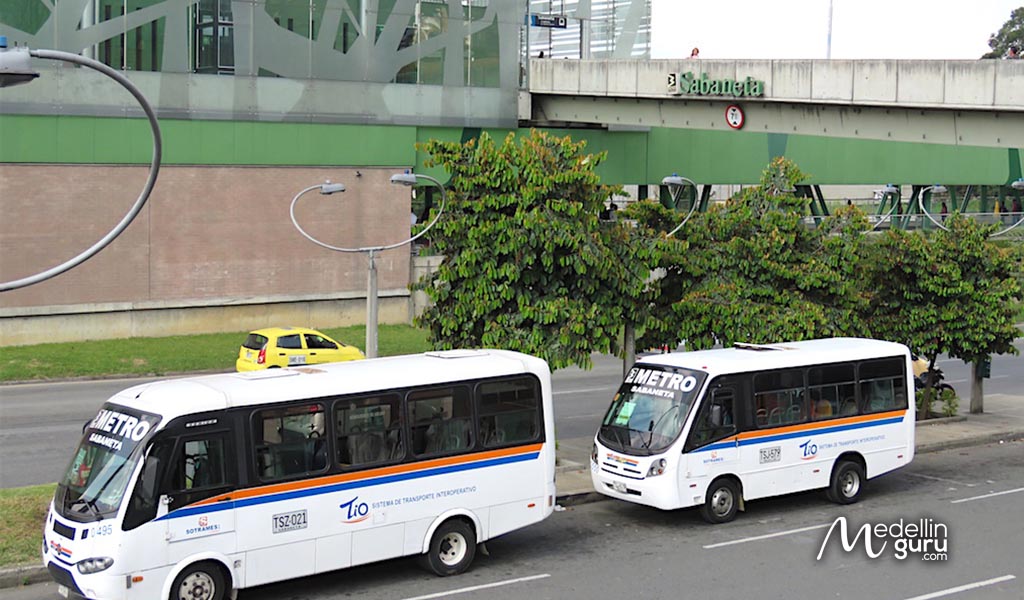
Metro feeder buses at Sabaneta station
The Civica card can also be used on the white integrated feeder buses that have Civica card readers. If an integrated bus has a Civica reader you can’t use integrated tickets for the lower fare bus/metro combination. And buses with a Civica reader only have the lower integrated fare available if you use a Civica card.
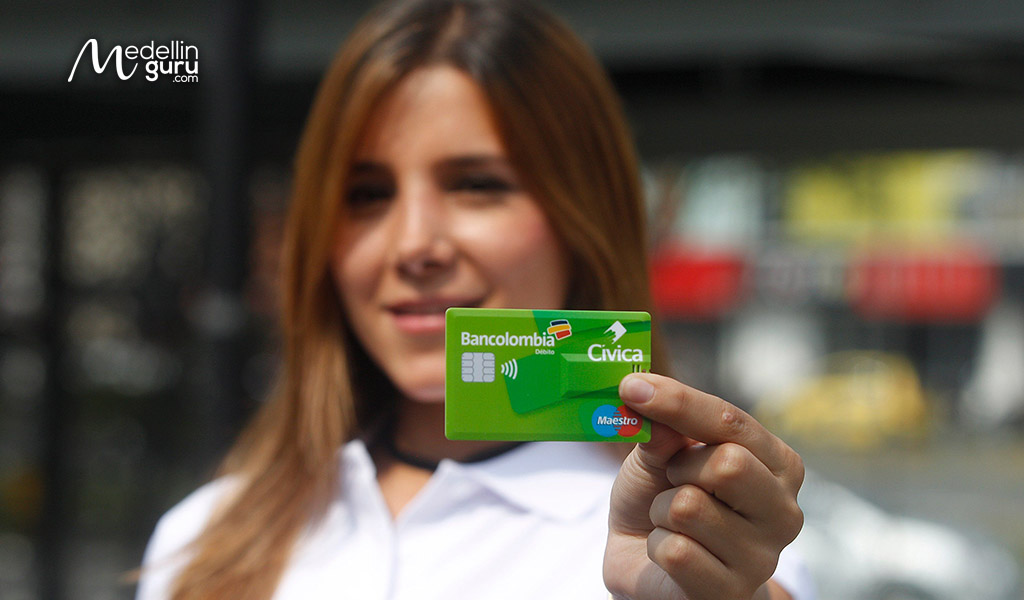
The Civica card can also be used on Encicla, which is Medellín’s free city bikes system
The Civica card is also used in the Encicla system, which is Medellín’s free city bikes system that permits you to borrow bikes from many stations throughout the city. Also, we have a guide to using and signing up for Encicla.
In addition, there at least one debit card that is multiple purpose and is also a Civica card, Bancolombia has one.
Considering that you save money with a Civica card, I don’t understand why there frequently are people standing in long lines to buy tickets.
Individual trip tickets are put on a card that is charged with one or more trips. You can buy one trip or additional trips in advance. When the card has no more money you deposit it in a slot. But a Civica card is rechargeable and has lower fares.
Reportedly there are only about 500,000 Civica cards issued. So, many users have to stand in long lines to buy tickets and don’t benefit from the discounted fares available with a Civica card.
Medellín Metro System Hours
The Medellín Metro system is open from Monday to Saturday each week from 4:30 am until 11 pm for all lines except for Line L to Parque Arvi.
On Sundays and most holidays, the hours are from 5 am to 10 pm. And 8:30 am to 10 pm on Line K and 9 am to 10 pm on Lines H, J and M. During Christmas Eve and New Year’s Eve the hours are normally shorter.
The Metrocable line to Parque Arvi (Line L) is closed on Mondays and runs from 9 am to 6 pm on Tuesday to Saturday. On Sunday and holidays Line L runs from 8:30 am to 6 pm.
Also, during some holidays like Christmas, the operating hours of the metro are typically reduced.
Medellin Metro Tips
Here are four tips for using the Medellín Metro:
- Get a Civica card. It doesn’t take much time to get one and you will save over 11 percent on fares plus you will avoid standing in the long ticket lines. Also, to get the integrated fare on integrated feeder buses with Civica readers you need a Civica card.
- Traveling on the metro is generally safe. However, watch out for pickpockets during rush hour or any time the trains are packed full of people. Also, watch out for people taking things from backpacks or bags. Several years ago, I lost a small camera that was in the small pocket in a backpack during rush hour. In addition, I recently had a phone stolen by a pickpocket during rush hour on the metro.
- The worst time to use the metro is during the evening rush on Monday to Friday. During this time trains are packed like sardines. So, try to avoid this evening rush hour. During the evening rush hours from about 5 pm to 7 pm, it could take you two to three trains to get on at busy stations like San Antonio or Poblado and you will be packed in like sardines.
- Learn the integrated bus routes. You can get to and from many neighborhoods in the Medellín metropolitan area on the integrated buses. For example, I can conveniently catch a bus outside my apartment building in Sabaneta and be at a metro station in less than 10 minutes. Furthermore, the buses will have the route/stops listed on signs in the front window.
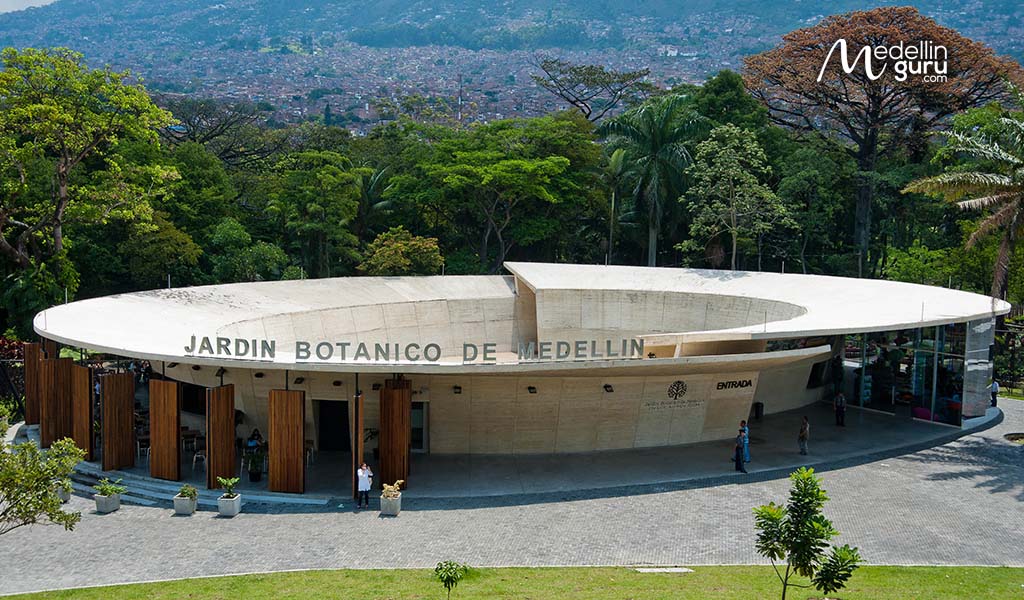
Jardín Botánico is near Universidad station, courtesy of Jardín Botánico
Using the Medellín Metro as a Tourist
If you are a tourist, you can use the metro system to get to many of the most popular tourist spots in Medellín. The following is a list of metro stations and several key tourist spots located nearby:
- Universidad – Jardín Botánico, Parque Norte, Parque Explora
- Parque Berrio – Museo de Antioquia, Plaza Botero, Iglesia de la Candelaria, Iglesia de la Veracruz, Rafael Uribe Uribe Palace of Culture
- Industriales – Museo de Arte Moderno
- Prado – Catedral Basílica Metropolitana, Iglesia Jesús Nazareno
- Sabaneta – Iglesia Santa Ana, Parque Sabaneta

Mayorca Mega Plaza is a short walk on a pedestrian bridge from Itagüí station
In addition, seven of the shopping malls in Medellín are located within a block or just a few blocks from a metro station:
- Itagüí station – Mayorca Mega Plaza mall
- Envigado station – Viva Envigado mall
- Poblado station – Monterrey mall
- Industriales station – Premium Plaza mall and Punto Clave mall
- Niquia station – Puerta del Norte mall
- Los Alpes station – Los Molinos mall
So, it is possible and convenient to get to many tourist spots and shopping malls in the metropolitan area by using the metro system. The Medellín Metro even provides a tourist guide (in Spanish) showing additional tourist spots you can get to using the metro system.

Pets can travel on the Medellín metro during specific hours but must be in a crate, container or cage
Are Pets Permitted on the Medellín Metro?
Yes, pets are permitted on the Medellín Metro system but there are some restrictions. Pets like dogs and cats can be taken on the Medellín metro system on Monday to Friday between 9:00 am and 3:00 pm and on Saturdays, Sundays and holidays between 9:00 am and 12:00 noon. During these hours pets are permitted on all parts of the metro system.
In addition, the pet must be in a crate, container or cage with maximum measures that are 60 cm wide, high and deep, which must be located on the floor and be solid enough to prevent it from escaping.
Are Bicycles Permitted on the Metro?
Yes, bicycles are permitted on the Medellín Metro system but there are restrictions. The metro system permits conventional bicycles on the trains of Lines A and B only during certain times of operation.
Cyclists may enter Line A and B trains with their bicycles on Monday through Friday between 8:00 pm and 11:00 pm, Saturdays from 4:00 pm to 11:00 pm and on Sundays and holidays from 5:00 am to 10:00 pm. In no case is there a need to pay an additional fare for bicycles.
Also, the most appropriate place to locate bicycles is the end of each train car with a space that is marked. Also, cyclists must yield to people with reduced mobility who require it.
In addition, cyclists must travel through metro stations and trains on foot and give priority to other users when entering and leaving trains. Furthermore, cyclists are not be able to use the elevators or the escalators to move, nor can they travel in train cars in which there are more than two bicycles.
The Future of the Medellín Metro
The Medellín Metro has a long-range master plan in place. In this master plan are many more planned expansions to the metro system.
The tranvía tramline T-A opened in early 2016. And the newest Metrocable line M opened in February 2019, 2019. These two expansions were part of the master plan. Near term expansions already in work include:
- Expand the Poblado station
- Complete the fifth Metrocable – line M (completed construction in January 2019 and opened on February 13, 2019)
- Add the third Metroplús elongated bus line between Envigado and Itagüí
- Add the sixth Metrocable – line P (completed construction in June 2021 and opened in June)
- Add a light rail along Avenida 80 running from Aguacatala to Caribe station
Also, they have been adding trains to the system to increase capacity. Additional trains added recently have reduced the time between trains during peak hours on Line A from every 3 minutes, 45 seconds to every 3 minutes.
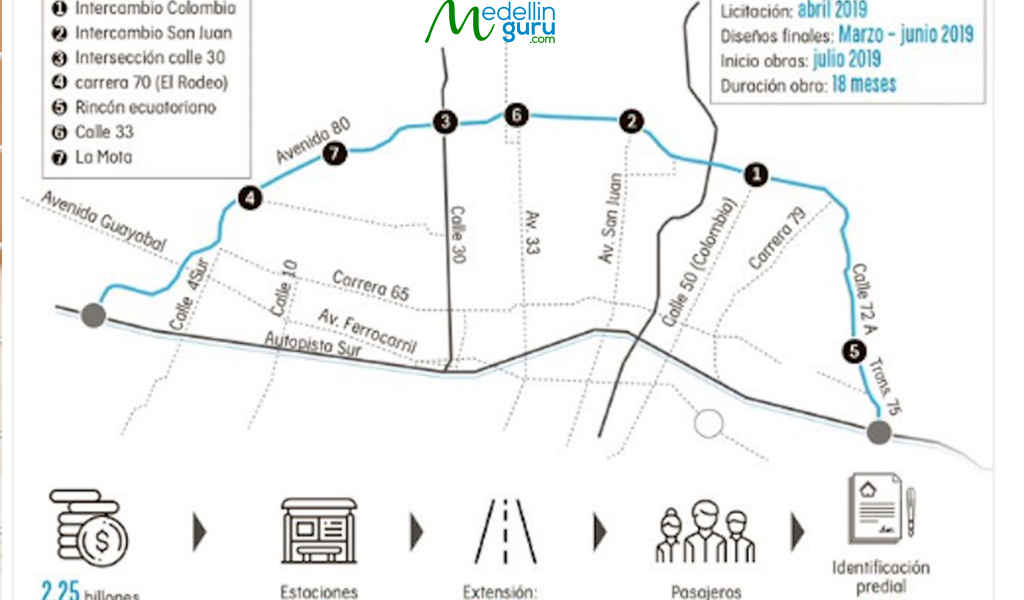
Route of the light rail project along Avenida 80 running from Aguacatala to Caribe station
Medellín is also working on a major expansion of the metro system that is a light rail project along Avenida 80 running from Aguacatala to Caribe station. The initial phase is budgeted at 1.3 billion pesos and will connect the Caribe metro station to the Floresta metro station.
Other expansions reportedly planned in the next few years include adding additional stations to Line A (between the Industriales and Poblado stations and between the Envigado and Itagüí stations).
Longer term expansions planned in the next 10+ years include adding a line from El Poblado to the South Bus Terminal, adding a tramline to José María Córdova international airport and adding a cable car system in Itagüí. In addition, a regional train system is in the planning stages.
So, more expansions are coming, which will continue to improve the public transportation system in Medellín.

Metrocable Line K
The Bottom Line: The Medellín Metro System
The Medellín Metro is considered a symbol for Medellín. And it is still the only rail-based metro system in Colombia. With its comprehensive transportation system, Medellín arguably has a world-class public transportation system that is considered the best out of all the cities in Colombia.
Other cities in Colombia only have elongated bus systems like TransMilenio in Bogotá, MIO in Cali, Metrolinea in Bucaramanga and Megabús in Pereira.
The largest city in Colombia, Bogotá, has been talking about and planning a rail-based metro for decades and still just a proposal that isn’t projected to be operational until perhaps 2024 at the the earliest.
With the inexpensive Medellín Metro system, extensive bus routes in the city with inexpensive fares as well as inexpensive taxis it is very possible to live in Medellín without a car. The good and inexpensive public transportation in the city is one of 27 reasons I chose to live in Medellín.
I have lived in Medellín for over eight years without a car and never even found the need to rent a car. And reportedly over 80 percent of expats living in Medellín don’t have a car.
Sign up for the Free Medellin Guru Newsletter – You can see all of the previous Medellin Guru weekly email newsletters and sign up here.
Editors note: updated on October 11, 2018 to add a more complete list of IDs accepted to get a metro Civica card.
Editors note: completely updated on January 1, 2019 with new 2019 metro fares.
Editors note: updated on January 22, 2019 to add a photo of Encicla, which is Medellín’s free city bikes system that permits you to to use your Metro Civica card to borrow bikes from many stations throughout the city.
Editors note: updated on February 3, 2019 to add information about the M Metrocable cable car line, which completed construction in January 2019. Also, added 2018 passenger statistics for the metro system.
Editors note: updated on February 13, 2019 with information that the M Metrocable cable car line is open.
Editors note: updated on February 26, 2019 with information about traveling with a pet on the metro system.
Editors note: updated on June 12, 2019 with information about the new major expansion of the Medellín metro, which is a light rail project along Avenida 80 running from Aguacatala to Caribe station.
Editors note: updated on June 15, 2019 with information that if you receive a discounted fare with a Civica card, the card only works once at an entrance so you can’t use the card for multiple passengers.
Editors note: updated on November 23, 2019 with information about traveling with a bicycle on the metro system.
Editors note: updated on December 19, 2019 with information that the Civica office in the Itagüí metro station has moved to the other side of the station.
Editors note: updated on January 1, 2020 with new Medellín metro system fares for 2020.
Editors note: updated on February 19, 2020 with information about the eventual Civica card, which now costs 5,000 pesos to purchase. Also, added information about the new O electric bus line that goes from Caribe station to the La Palma Metroplús station.
Editors note: updated on April 3, 2020 with information that face masks will be required on the Medellín metro starting on April 7. Also, added that police at metro stations are now checking IDs and you are permitted to use the metro based on Pico y Cedula.
Editors note: updated on September 4, 2020 to remove that Pico y Cedula is used on the Medellin Metro since Pico y Cedula ended on August 30 in Medellín and the Aburrá Valley.
Editors note: completely updated on January 19, 2021 with new 2021 metro fares.
Editors note: updated on June 11, 2021 with information that the sixth Metrocable cable car line has opened, line P.
Editors note: completely updated on January 1, 2022 with new 2022 metro fares.
Editors note: completely updated on July 14, 2023 with new 2023 metro fares.

